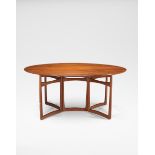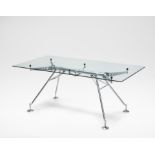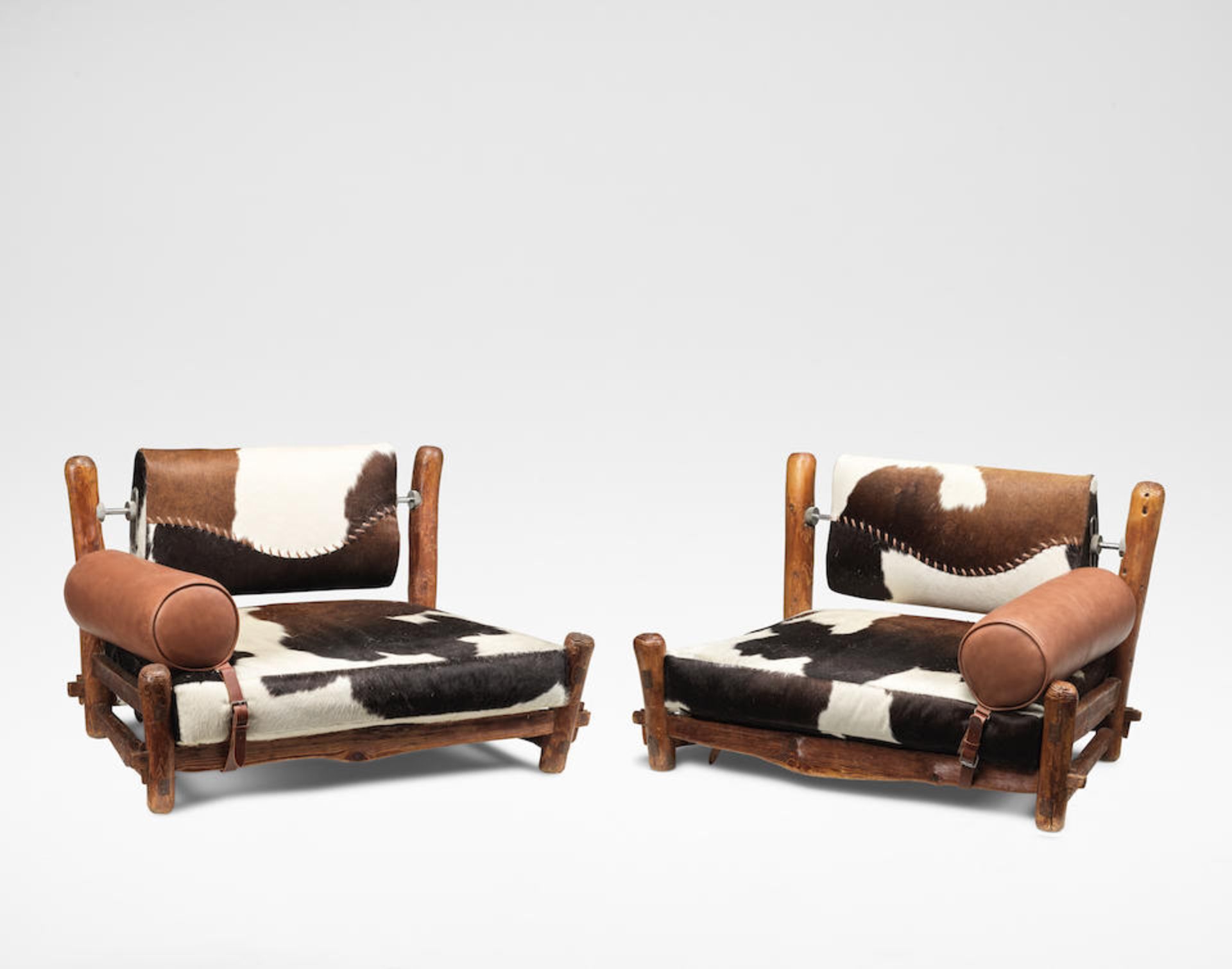129
Berthold Lubetkin and Margaret Lubetkin Pair of rare armchairs, designed for the Penthouse flat,...
Berthold Lubetkin and Margaret Lubetkin Pair of rare armchairs, designed for the Penthouse flat, Highpoint Two, Highgate, London, 1936-1938 Norwegian yew, sandblasted pine, cowhide, leather, chromium-plated metal. Each: 72 x 117 x 80 cm Footnotes: Provenance Berthold Lubetkin, Penthouse flat, Highpoint Two, Highgate, London Thence by descent Bonhams, London, New Bond Street, 'Important Design', 25 April 2018, lot 110 Acquired from the above by the present owner Literature Lionel Brett, The Things We See, No. 2: Houses, Middlesex, 1947, illustrated p. 49 'Tall Order', The Architects' Journal, June 1985, illustrated p. 55 John Allan, Berthold Lubetkin: Architecture and the tradition of progress, London, 2016, illustrated pp. 303, 305, 307, 56 The Victoria and Albert Museum, London, Collections, https://collections.vam.ac.uk/item/O1458096/-armchairberthold-lubetkin, (accessed April 2024) Highpoint by Nick Wright 'There are only four kinds of artistic activity: fine art, music, poetry and ornamental pastry cooking, of which architecture is a minor branch'. So began Berthold Lubetkin's speech to the Art Worker's Guild in 1932. Over a fifty-year career he cooked many fine pastries. His origins are opaque. A passport showing his birthplace as Warsaw in 1903 was false. He was born in Georgia, a colonial outpost of Tsarist Russia, in 1901. During the Russian revolution he enrolled as a student at the Stroganov School of Applied Art, then studied carpet design in Berlin, architecture in Warsaw and concrete construction in Paris under August Perret, an extended education at the end of which he had few if any formal qualifications. Nonetheless, he was chosen to work on the Soviet Pavilion in the Paris Exposition of 1925 and, in partnership, with Jean Ginsburg whose bona fide degree facilitated planning permission, had built a modernist apartment block on Rue de Versailles by the age of 30. Arriving in Britain with two passports, no family or verifiable CV, he was free to become the architect of his own identity. His nationality was International, his faith communism, the denomination Modernism. The penguin pool he designed for Regent Park Zoo became emblematic of the movement. More commissions came; suburban houses in Plumstead, a beach house in Aldwyck, a bungalow cut into the chalk hills of Whipsnade, then, following the Tottenham factory he designed for Gestetner Ltd, he designed Highpoint for the same patron. 'Nothing,' he said, 'is too good for the ordinary person' and Highpoint 1 is the physical embodiment of that ideal. New materials, concrete, glass, and steel were presumed impervious to the elements, the elemental design to the vicissitudes fashion but, although undeniably 'an achievement of the first rank' to quote Le Corbusier, Highpoint 1 now appears very much of its time. Rather than housing the workers of the Gestetner office equipment manufacturer as planned, the apartments were sold to private individuals whilst the white-washed concrete appears an homage to white liner modernism, new in Britain but rehearsed the decade prior on the Mediterranean coast and already rust streaked. It is the adjacent Highpoint II which was the more forward-thinking building, bridging as it does the stark modernity of its elder sibling on one side, with historic Highgate on the other. The choice of Staffordshire blue brick nods to the Victorian engineers such as Brunel whom Lubetkin admired, the glass bricks of the stair wells were contemporary. Then there are the caryatids. Classical figures cast at the British Museum support the modernist portico but have remained a source of debate to this day. Are they 'pastry decoration'? Are they a recreation of the figures on a childhood home? Or are they in fact the earliest postmodern joke, an acknowledgement that an important 'function' of architecture is to entertain? In 1951 Lubetkin wrote 'for too long modern architectural solutions were regarded in terms of abstract principles, with formal expression left to itself as a functional resultant. The principles of composition, the emotional impact of the visual, were brushed aside as irrelevant. Yet this is the very material with which the architect operates.' Alessandro Mendini was regarded as revolutionary for making much the same point fifty years after Highpoint's construction. Preeminent among the residents of Highpoint II was Lubetkin himself who had designed the penthouse for his family and the apartment displays the same meld of old and new. A vaulted ceiling recalls the breakfast room at John Soane's Pitzhanger, suspended from it was a mobile made by Alexander Calder. Expansive glass affords views of London, in the free space below was a suite of furniture designed in the vernacular style of Lubetkin's native Georgia. John Allen writes of Lubetkin's furniture: 'No longer content merely to revere the grand tradition of architects who design their own furniture – Aalto, Le Corbusier, Mies, Rietveld – he now steps up to join it. The low chairs and sofa were unique pieces of soft sculpture made personally by Lubetkin and his wife Margaret from hand chosen lengths of Norwegian yew and cow hide from Argentina.' Such a quest seems indulgent but careful selection of the timber is necessary to the design. The rear posts all require the same curvature to achieve symmetry, even the knots are regularly spaced in the aprons and, as with the building for which they were designed, the traditional and avant-guard coexist; fitted into the rustic frames are aerofoil sections adjusted by engine-turned bosses. These pieces of furniture are of real architectural significance - evidenced by the Victoria and Albert Museum's acquisition of the third chair. They were designed by the architect responsible for much of Britain's post-war social housing and the Finsbury Health Centre, effectively the first hospital for the NHS. They drew on his early life in Georgia yet sit well in his home on top of Britain's preeminent modernist building. Indeed, so attached was Lubetkin to the furniture that on leaving Highpoint in 1955, much of the suite went with him. Images of the farm cottage to which he relocated show sofa and chair wedged beside the hearth. Then when he retired to a terraced Georgian house in Bristol, the pieces again accompanied him. Throughout a transient life it was as though this suite represented home more than any building. Perhaps home had always been Georgia. Bonhams wishes to thank Nick Wright, co-author, Cut and Shut: The History of Creative Salvage, London, 2012 This lot is subject to the following lot symbols: TP TP For auctions held in Scotland: Lots will be moved to an offsite storage location (Constantine, Constantine House, North Caldeen Road, Coatbridge ML5 4EF, Scotland, UK) and will only be available for collection from this location at the date stated in the catalogue. Please refer to the catalogue for further information. For all other auctions: Lots will be moved to an offsite storage location (Cadogan Tate, Auction House Services, 241 Acton Lane, London NW10 7NP, UK) and will only be available for collection from this location at the date stated in the catalogue. Please note transfer and storage charges will apply to any lots not collected after 14 calendar days from the auction date. For further information on this lot please visit Bonhams.com For further information about this lot please visit the lot listing
Berthold Lubetkin and Margaret Lubetkin Pair of rare armchairs, designed for the Penthouse flat, Highpoint Two, Highgate, London, 1936-1938 Norwegian yew, sandblasted pine, cowhide, leather, chromium-plated metal. Each: 72 x 117 x 80 cm Footnotes: Provenance Berthold Lubetkin, Penthouse flat, Highpoint Two, Highgate, London Thence by descent Bonhams, London, New Bond Street, 'Important Design', 25 April 2018, lot 110 Acquired from the above by the present owner Literature Lionel Brett, The Things We See, No. 2: Houses, Middlesex, 1947, illustrated p. 49 'Tall Order', The Architects' Journal, June 1985, illustrated p. 55 John Allan, Berthold Lubetkin: Architecture and the tradition of progress, London, 2016, illustrated pp. 303, 305, 307, 56 The Victoria and Albert Museum, London, Collections, https://collections.vam.ac.uk/item/O1458096/-armchairberthold-lubetkin, (accessed April 2024) Highpoint by Nick Wright 'There are only four kinds of artistic activity: fine art, music, poetry and ornamental pastry cooking, of which architecture is a minor branch'. So began Berthold Lubetkin's speech to the Art Worker's Guild in 1932. Over a fifty-year career he cooked many fine pastries. His origins are opaque. A passport showing his birthplace as Warsaw in 1903 was false. He was born in Georgia, a colonial outpost of Tsarist Russia, in 1901. During the Russian revolution he enrolled as a student at the Stroganov School of Applied Art, then studied carpet design in Berlin, architecture in Warsaw and concrete construction in Paris under August Perret, an extended education at the end of which he had few if any formal qualifications. Nonetheless, he was chosen to work on the Soviet Pavilion in the Paris Exposition of 1925 and, in partnership, with Jean Ginsburg whose bona fide degree facilitated planning permission, had built a modernist apartment block on Rue de Versailles by the age of 30. Arriving in Britain with two passports, no family or verifiable CV, he was free to become the architect of his own identity. His nationality was International, his faith communism, the denomination Modernism. The penguin pool he designed for Regent Park Zoo became emblematic of the movement. More commissions came; suburban houses in Plumstead, a beach house in Aldwyck, a bungalow cut into the chalk hills of Whipsnade, then, following the Tottenham factory he designed for Gestetner Ltd, he designed Highpoint for the same patron. 'Nothing,' he said, 'is too good for the ordinary person' and Highpoint 1 is the physical embodiment of that ideal. New materials, concrete, glass, and steel were presumed impervious to the elements, the elemental design to the vicissitudes fashion but, although undeniably 'an achievement of the first rank' to quote Le Corbusier, Highpoint 1 now appears very much of its time. Rather than housing the workers of the Gestetner office equipment manufacturer as planned, the apartments were sold to private individuals whilst the white-washed concrete appears an homage to white liner modernism, new in Britain but rehearsed the decade prior on the Mediterranean coast and already rust streaked. It is the adjacent Highpoint II which was the more forward-thinking building, bridging as it does the stark modernity of its elder sibling on one side, with historic Highgate on the other. The choice of Staffordshire blue brick nods to the Victorian engineers such as Brunel whom Lubetkin admired, the glass bricks of the stair wells were contemporary. Then there are the caryatids. Classical figures cast at the British Museum support the modernist portico but have remained a source of debate to this day. Are they 'pastry decoration'? Are they a recreation of the figures on a childhood home? Or are they in fact the earliest postmodern joke, an acknowledgement that an important 'function' of architecture is to entertain? In 1951 Lubetkin wrote 'for too long modern architectural solutions were regarded in terms of abstract principles, with formal expression left to itself as a functional resultant. The principles of composition, the emotional impact of the visual, were brushed aside as irrelevant. Yet this is the very material with which the architect operates.' Alessandro Mendini was regarded as revolutionary for making much the same point fifty years after Highpoint's construction. Preeminent among the residents of Highpoint II was Lubetkin himself who had designed the penthouse for his family and the apartment displays the same meld of old and new. A vaulted ceiling recalls the breakfast room at John Soane's Pitzhanger, suspended from it was a mobile made by Alexander Calder. Expansive glass affords views of London, in the free space below was a suite of furniture designed in the vernacular style of Lubetkin's native Georgia. John Allen writes of Lubetkin's furniture: 'No longer content merely to revere the grand tradition of architects who design their own furniture – Aalto, Le Corbusier, Mies, Rietveld – he now steps up to join it. The low chairs and sofa were unique pieces of soft sculpture made personally by Lubetkin and his wife Margaret from hand chosen lengths of Norwegian yew and cow hide from Argentina.' Such a quest seems indulgent but careful selection of the timber is necessary to the design. The rear posts all require the same curvature to achieve symmetry, even the knots are regularly spaced in the aprons and, as with the building for which they were designed, the traditional and avant-guard coexist; fitted into the rustic frames are aerofoil sections adjusted by engine-turned bosses. These pieces of furniture are of real architectural significance - evidenced by the Victoria and Albert Museum's acquisition of the third chair. They were designed by the architect responsible for much of Britain's post-war social housing and the Finsbury Health Centre, effectively the first hospital for the NHS. They drew on his early life in Georgia yet sit well in his home on top of Britain's preeminent modernist building. Indeed, so attached was Lubetkin to the furniture that on leaving Highpoint in 1955, much of the suite went with him. Images of the farm cottage to which he relocated show sofa and chair wedged beside the hearth. Then when he retired to a terraced Georgian house in Bristol, the pieces again accompanied him. Throughout a transient life it was as though this suite represented home more than any building. Perhaps home had always been Georgia. Bonhams wishes to thank Nick Wright, co-author, Cut and Shut: The History of Creative Salvage, London, 2012 This lot is subject to the following lot symbols: TP TP For auctions held in Scotland: Lots will be moved to an offsite storage location (Constantine, Constantine House, North Caldeen Road, Coatbridge ML5 4EF, Scotland, UK) and will only be available for collection from this location at the date stated in the catalogue. Please refer to the catalogue for further information. For all other auctions: Lots will be moved to an offsite storage location (Cadogan Tate, Auction House Services, 241 Acton Lane, London NW10 7NP, UK) and will only be available for collection from this location at the date stated in the catalogue. Please note transfer and storage charges will apply to any lots not collected after 14 calendar days from the auction date. For further information on this lot please visit Bonhams.com For further information about this lot please visit the lot listing






